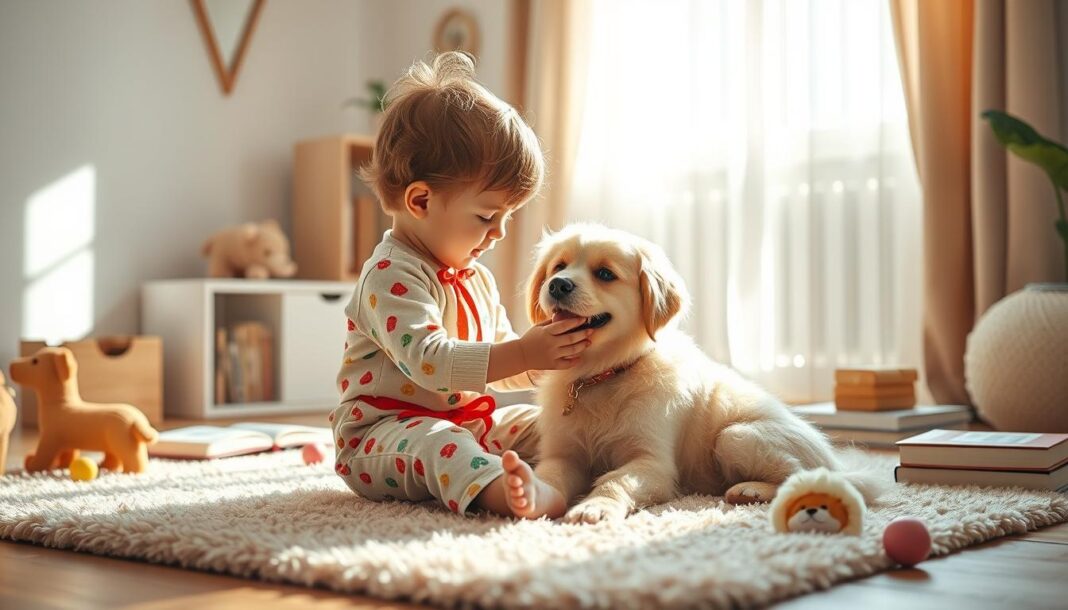As a parent, you know how great it is to have a furry friend at home. Studies show that children who grow up with pets learn important life skills. These include empathy and responsibility.
Gail F. Melson, PhD, from Purdue University, found many benefits for kids with pets. They have better self-esteem and social skills. Adding pet care to your parenting tips helps create a caring home. This supports healthy child development.
Exploring pet care and parenting can be very rewarding. It’s good for the whole family. Knowing the benefits and challenges helps make a happy home for both kids and pets.
The Benefits of Raising Pets Alongside Children
Children who grow up with pets often gain many benefits. These include better emotional intelligence, social skills, and physical health. Pets create a caring environment that helps kids grow and develop.
Emotional Development Benefits
Having pets can greatly help children emotionally. Pets offer companionship, which can reduce loneliness and anxiety. Research shows that kids with pets tend to have higher emotional intelligence.
For example, a study by Mary Renck Jalongo, PhD, found that reading to pets can improve reading skills and confidence in children.
- Developing empathy through pet care
- Learning to manage emotions through pet interactions
- Building confidence through pet-related activities
Social Skills Enhancement
Pets also help children improve their social skills. They teach kids how to communicate, be responsible, and show compassion. By caring for pets, children learn to understand and meet their needs.
- Improving communication skills through pet interactions
- Developing responsibility through pet care tasks
- Enhancing compassion and empathy towards pets
Physical Health Advantages
Living with pets can also boost a child’s physical health. Early exposure to pets may lower the risk of allergies and asthma. Pets also encourage kids to be active, like playing or walking them.
- Reducing the risk of allergies and asthma
- Encouraging physical activity through pet care
- Promoting a healthy lifestyle through pet ownership
Choosing the Right Pet for Your Family
Finding the perfect pet for your family is important. It depends on your lifestyle, your kids’ ages, and how much space and time you have. This choice affects everyone’s happiness, including your pet’s.
Assessing Your Family’s Lifestyle
Your family’s lifestyle is key in picking the right pet. Think about your daily routine, work hours, and how much time you can spend with your pet. If you’re always busy, a pet that’s easy to care for might be best.
Age-Appropriate Pet Choices
The age of your kids is also very important. Different pets are better for different ages to keep everyone safe and happy.
Pets for Toddlers and Preschoolers
Young kids need pets that are gentle and simple to care for. Fish or small, calm animals like guinea pigs are great choices.
Pets for Elementary School Children
Older kids can help more with pet care. Dogs, cats, or small pets like hamsters are good options.
Pets for Teenagers
Teenagers can handle more pet care tasks. They might like pets that need more interaction, like dogs that need walks or cats that like grooming.
Space and Time Considerations
How much space you have and how much time you can spend on pet care are crucial. Big pets need lots of room to move and play. But, small pets need less space and still need regular care.
Key considerations include:
- Available space in your home for the pet to live and exercise.
- Time for regular feeding, grooming, and exercise.
- The financial resources to provide for the pet’s needs.
Dogs as Family Pets
Dogs can be great family pets if they fit your family’s lifestyle. They bring joy and teach kids about responsibility and empathy.
Child-Friendly Dog Breeds
Choosing the right dog breed is key, even more so with young children. Some breeds are naturally better with kids due to their temperament and size.
Small to Medium-Sized Family Dogs
Small to medium-sized dogs are perfect for smaller homes. Breeds like the Beagle, Cocker Spaniel, and Collie are gentle and love kids.
Large Family-Friendly Dogs
Large dogs can also be great for families, if they’re calm and not too energetic. The Labrador Retriever, Golden Retriever, and Newfoundland are known for being patient with kids.
| Breed | Size | Temperament |
|---|---|---|
| Beagle | Small | Friendly, Curious |
| Labrador Retriever | Large | Gentle, Intelligent |
| Cocker Spaniel | Medium | Loving, Outgoing |
Training Dogs to Interact with Children
Teaching your dog to safely interact with kids is essential. Use positive reinforcement to teach them basic commands and make them comfortable around children.
Managing Dog-Child Relationships
It’s important to manage how your dog and child interact. Supervise their time together, teach kids how to gently play with dogs, and give your dog a safe space.
By picking the right breed and training your dog, you can create a loving home for both your dog and kids.
Cats and Children: Creating Harmony
Creating harmony between cats and children in the same household requires careful consideration and planning. Cats can be a great addition to families with kids, teaching them valuable lessons about responsibility and compassion. It’s essential to choose a cat that is tolerant of children and to teach children how to interact with cats gently.
Selecting a Child-Friendly Cat
When selecting a cat for a family with children, look for breeds known for their calm and patient nature. Some cat breeds are more suited to families with children than others. For example, British Shorthairs and Maine Coons are often recommended due to their gentle and affectionate personalities. It’s also crucial to observe how the cat interacts with children before making a decision.
Teaching Children to Respect Feline Boundaries
Teaching children to respect a cat’s boundaries is vital for creating a harmonious household. Children should be taught to gently pet the cat and to recognize signs of irritation or stress, such as hissing or tail swishing. Encouraging children to respect a cat’s personal space helps prevent conflicts and ensures a safe environment for both the cat and the child.
Creating Safe Spaces for Cats
Creating safe spaces for cats is essential in a household with children. Cats need areas where they can retreat from the hustle and bustle of family life. Providing cat trees or quiet rooms can help cats feel secure and reduce stress. This not only benefits the cat but also helps children understand and respect the cat’s need for alone time.
Small Pets for Beginners
Getting a small pet is a wonderful way to teach kids about caring for animals. These pets are easy to look after and can be a fun learning experience.
Hamsters, Gerbils, and Mice
Hamsters, gerbils, and mice are great pets for beginners. They are friendly and don’t need much care. Hamsters are nocturnal, so they’re active at night, perfect for kids who are home after school. Gerbils are curious and friendly, while mice are smart and fun to watch.
Guinea Pigs and Rabbits
Guinea pigs and rabbits are gentle and make great pets for kids. They are easy to care for and love to be around people. Guinea pigs are social animals and do well in pairs or groups. Rabbits are smart and can learn to use a litter box.
Fish and Aquatic Pets
Fish are a great first pet for kids, teaching them about regular care. They come in many colors and species, making them pretty to look at. Aquatic pets like frogs and turtles are also interesting, but need more care.
Reptiles and Amphibians
For a unique pet, consider reptiles or amphibians. They need special care, like the right light and temperature. But, they can teach kids a lot about different ecosystems and animal needs.
Think about your family’s lifestyle and how much time you can spend on pet care before choosing a small pet. The right pet can bring happiness and learning to your family.
Raising Pets Alongside Children: Safety First
When you have pets and kids at home, safety is key. It’s important to keep both pets and children safe and happy. This means stopping animal bites, managing allergies, and making safe places for them to play together.
Preventing Animal Bites and Scratches
It’s important to stop animal bites and scratches when you have pets and kids. Teach your kids to be gentle with pets and respect their space. Supervision is crucial to avoid any bad interactions. Also, make sure your pet is friendly and well-trained around kids.
Allergies and Health Concerns
Many kids are allergic to pets. So, watch your child’s health when you get a new pet. If your kid has allergies, pick pets that don’t make them sick. Keeping your pet clean and your home tidy can also help.
Creating Safe Interaction Zones
Make special areas where pets and kids can play together safely. These spots should be safe and big enough for everyone. This way, you can avoid accidents and make a happy place for both.
Supervising Pet-Child Interactions
Supervision is very important when pets and kids are together. Always watch them, at least in the beginning. This helps you step in if needed and teach them how to get along.
Teaching Children Pet Care Responsibilities
Involve kids in pet care to teach them compassion and responsibility. This helps both the child and the pet. Give tasks that fit the child’s age to make it fun and educational.
Age-Appropriate Pet Care Tasks
Children can start learning pet care early. Tasks should match the child’s age and development.
Toddler and Preschooler Tasks
- Petting the pet gently
- Helping to prepare pet food (under supervision)
- Refreshing the pet’s water bowl
Elementary School Children Tasks
- Feeding the pet
- Cleaning the pet’s living area (with supervision)
- Assisting in grooming
Tween and Teen Responsibilities
- Taking full responsibility for certain pet care tasks
- Monitoring the pet’s health and behavior
- Participating in pet training and exercise
Creating Pet Care Routines
Make a routine to help kids remember their tasks. Create a schedule for daily and weekly tasks. Use a chart or app to make it fun.
Monitoring and Supporting Child-Pet Interactions
Always watch when kids and pets are together. Encourage gentle and respectful behavior towards pets. Be ready to answer questions and guide on pet care.
Teaching kids about pet care helps them learn important life skills. They learn empathy, responsibility, and compassion.
Managing Pet Health with Children in the Home
When you have kids at home, taking care of your pet’s health is key. You need to make sure they get regular vet visits, know when they’re sick, and know how to handle emergencies. This way, everyone stays healthy and safe.
Regular Veterinary Care
It’s important to take your pet to the vet regularly. Schedule annual vaccinations and health checks to catch health problems early. Your vet can also give advice on food, parasites, and more.
Some things to talk about with your vet include:
- Nutrition and diet recommendations
- Parasite control measures
- Spaying or neutering
- Microchipping for identification
Recognizing Signs of Pet Illness
Knowing when your pet is sick is crucial. Watch for changes in behavior, appetite, or physical condition, like vomiting or being really tired. If you see anything odd, call your vet.
Some common signs of illness in pets are:
- Changes in appetite or water intake
- Vomiting or diarrhea
- Lethargy or depression
- Changes in urination or stool quality
Handling Pet Emergencies
If there’s a pet emergency, stay calm and act fast. Keep a pet first aid kit handy and have your vet’s number ready. Common emergencies include injuries, poisoning, or serious illness.
Teaching Children About Pet Health
Teaching your kids about pet health is important. Teach them to recognize signs of illness or distress and tell you if they see anything. This helps keep your pet healthy and teaches your kids responsibility.
Addressing Common Challenges
Raising pets with children comes with its own set of challenges. It’s key to know these hurdles and how to tackle them. When you bring a new pet home, be ready for any issues that might pop up.
Dealing with Jealousy Between Pets and Children
Jealousy can be a big problem when you introduce a new pet. Make sure everyone gets enough attention. Here’s how:
- Spending quality one-on-one time with your children
- Engaging in activities that involve both children and pets
- Rewarding positive behavior in both children and pets when they interact harmoniously
Managing Fears and Anxieties
Children and pets can sometimes develop fears of each other. To handle these fears, do the following:
- Gradually introduce children and pets to each other in a controlled environment
- Teach children how to gently and respectfully interact with pets
- Supervise interactions closely to prevent any adverse reactions
Handling Pet Messes and Accidents
Accidents happen when you have pets and kids. To lessen the impact:
- Establish a routine for cleaning up after pets
- Teach children the importance of helping with simple pet care tasks
- Keep a close eye on pets, specially in areas prone to accidents, like food and water areas
By tackling these common challenges, you can make a better home for both pets and kids. It’s all about creating a peaceful and happy environment for everyone.
The Role of Parents in Pet-Child Relationships
Parents play a key role in making sure pets and kids get along well. Your help and watchful eye are crucial. This way, both pets and children can live happily together in your home.
Setting Clear Boundaries and Rules
It’s important to set clear rules for both kids and pets. Setting these boundaries early on helps avoid bad behavior. For instance, teaching kids not to bother pets when they’re eating or sleeping can stop fights.
Modeling Proper Animal Treatment
Children learn a lot from watching their parents. So, it’s key to model proper animal treatment yourself. This means being gentle with pets, giving them a safe place, and showing love the right way. This teaches your kids to treat pets with kindness and respect.
Intervening When Necessary
Even with the best planning, pets and kids might still have disagreements. It’s vital to intervene promptly and fairly when these happen. This could mean separating the pet and child, or teaching the child how to handle the situation calmly. Your quick action keeps the peace and shows kids the rules you’ve set.
Life Lessons Children Learn From Pets
Having pets helps kids learn important lessons. They learn about empathy, responsibility, and the life cycle of living beings. These skills are crucial for their future.
Empathy and Compassion
Caring for pets teaches kids empathy and compassion. They learn to think about others’ feelings. This skill helps them make better relationships with people too.
Responsibility and Commitment
Having a pet shows kids the value of responsibility and commitment. They learn to care for their pet every day. This teaches them to be responsible and understand the importance of keeping promises.
| Pet Care Task | Responsibility Learned | Benefit to Child |
|---|---|---|
| Feeding | Nourishing another living being | Understanding the importance of regular care |
| Grooming | Maintaining hygiene and health | Developing fine motor skills and empathy |
| Providing Fresh Water | Ensuring the pet’s basic needs are met | Learning about the importance of hydration |
Understanding Life Cycles and Loss
Having a pet teaches kids about life cycles and loss. They see how pets grow, age, and eventually pass away. This helps them understand and deal with loss.
Balancing Pet Needs with Family Life
When you have pets and kids, it’s key to balance their needs. Pets need care just like kids do. A happy home needs planning.
Creating Pet-Friendly Family Routines
Setting up routines for pets and family can make everyone happier. Make time for pet care like feeding and walks. It teaches kids about caring for others.
Here are some tips for pet-friendly routines:
- Feed pets at the same time every day
- Plan walks or playtime in your schedule
- Get kids involved in pet care
Vacations and Travel Considerations
Traveling with pets can be tough, but there are ways to make it work. Look for pet-friendly hotels or rentals. Or, consider pet-sitting or boarding if your pet can’t come along.
When traveling with pets, remember:
- Keep your pet’s shots current
- Don’t forget their food and meds
- Find pet-friendly places and activities
Managing Pet Expenses in the Family Budget
It’s important to keep pet costs in check. Start by figuring out monthly pet expenses. You might need to save for pet care or adjust your budget.
Here are some tips for handling pet costs:
- Look for pet insurance deals
- Buy pet supplies in bulk
- Choose affordable pet care options
Conclusion
Raising pets with children needs effort, patience, and understanding. This article has given you tips to make a loving home for pets and kids. You’ve learned how pets help kids grow emotionally, socially, and physically.
We talked about picking the right pet for your family. We also covered managing pet and child relationships and teaching kids how to care for pets. By thinking about your family’s lifestyle and your pet’s needs, you can make a happy home for everyone.
Remember, adding pets to your family is a rewarding journey. It takes commitment and dedication. With the right approach, you can build a strong bond between your kids and pets. This bond promotes empathy, responsibility, and compassion. In short, raising pets with children is a great experience that brings many benefits to your family.



